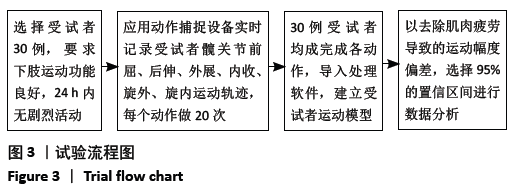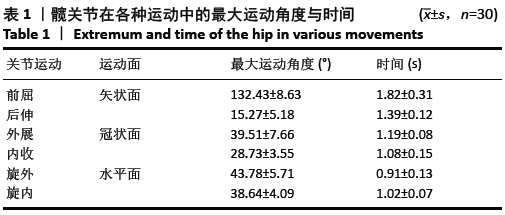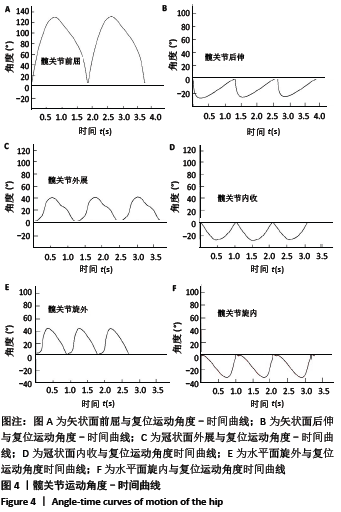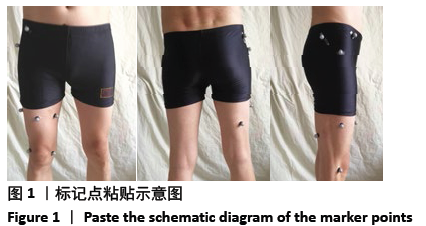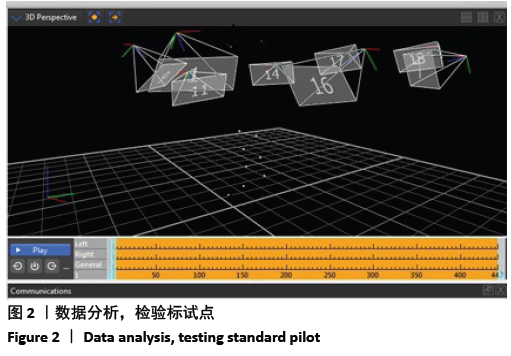[1] 郭敏.老年人盲目健身, 当心半月板损伤[N]. 中国中医药报,2018-5-4.
[2] 李彦林.运动医学-新兴的朝阳学科[J].昆明医科大学学报,2014, 35(3):1-3.
[3] CULIVER A, GARRISON JC, CREED KM, et al. Correlation Among Y-Balance Test-Lower Quarter Composite Scores, Hip Musculoskeletal Characteristics, and Pitching Kinematics in NCAA Division I Baseball Pitchers. J Sport Rehabil. 2019;28(5):432-437.
[4] KERRIGAN DC, THIRUNARAYAN MA, SHEFFLER LR, et al. A tool to assess biomechanical gait efficiency: a preliminary clinical study. Am J Phys Med Rehabil. 1996;75(1):3-8.
[5] SCHUTTE LM, NARAYANAN U, STOUT JL, et al. An index for quantifying deviations from normal gait. Gait Posture. 2000;11(1):25-31.
[6] 孙嘉利,唐丹,钟世镇.三维步态分析的研究与应用[J].中国组织工程研究与临床康复,2007,11(5):944-948.
[7] 赵辉,吴海山.步态分析在全膝关节置换手术中的应用[J].中华骨科杂志,2010,30(6):630-634.
[8] 王宇,郑义,张健.髓关节主动运动幅度与被动运动幅度的定量关系[C]. 中国运动生物力学分会,深圳,2018.
[9] 王辉昊,张旻,牛文鑫,等.三维运动捕捉技术在颈椎整复手法中肢体运动轨迹的在体研究[J].中国骨伤,2015,28(10):940-944.
[10] 谭菁华,晏怡果.光学式三维运动捕捉在运动系统相关研究中的应用[J].海南医学,2018,29(14):2029-2332.
[11] 韩树洋.人体关节生物力学实验及仿真研究[D].徐州:中国矿业大学,2014:1-148.
[12] 毛玉瑢,陈娜,陈沛铭,等.健康中老年人上肢负重状态下利手和非利手的三维运动学分析[J].中国组织工程研究,2015,19(42): 6776-6781.
[13] 马倩颖,吴瑞林,王亚猛,等.基于动作捕捉的减重条件下心理疲劳状态测量技术[J].航天医学与医学工程,2019,32(4):291-298.
[14] 苏健蛟,张颖慧,马世坤.不同级别优秀散打运动员鞭腿技术动作特征及其对击打速度的影响[J].武汉体育学院学报,2018,52(1): 87-94.
[15] 张振华,刘永涛.全髋关节置换后髋关节前屈后伸活动范围计算[J].临床医学工程,2010,17(2):4-6.
[16] 刘永涛,张振华.髋臼外展角与前倾角动态变化规律的数学方法解析[J].中国组织工程研究与临床康复,2009,13(35):6973-6975.
[17] 张浩,陈子超.增强式训练对运动员下肢运动能力影响的Meta分析[J].湖北体育科技,2020,39(4):318-322+330.
[18] 王书海,赵海浪,武少广,等.人体下肢运动能力测评研究[J].河北工业科技,2016,33(6):474-478.
[19] 冯利正,陈健.运动捕捉技术在体育运动中的应用[J].杭州师范学院学报(医学版),2005,25(5):419-422.
[20] 邱晓文,贺西京,黄思华,等.人体脊柱三维运动测量分析方法新进展[J].中国骨伤,2015,28(5):476-481.
[21] 谭菁华,晏怡果.光学式三维运动捕捉在运动系统相关研究中的应用[J].海南医学,2018,29(14):2029-2032.
[22] BAKKE D, BESIER T. Shape model constrained scaling improves repeatability of gait data. J Biomech. 2020;107:109838.
[23] 戴园园. 老年人上下楼梯的运动学分析[D].广州:广州体育学院, 2019.
[24] 张宇宬,郝卫亚,李建设,等.优秀运动员两种跳马动作落地的运动学分析[J].浙江体育科学,2019,41(1):102-107.
[25] 彭志强,敬龙军.我国柔韧素质训练研究发展趋势及可视化分析[J].体育科技文献通报,2020,28(7):157-160.
[26] 王雪,赵成玉,白灵丽,等.中国社区居家养老现状[J].中国老年学杂志,2019,39(4):1012-1015.
[27] 陈红.老年人健康状况及其影响因素分析[D].石家庄:河北大学, 2017:1-60.
[28] 王晶晶,葛高琪,郭翼天,等.国内外社区居家养老模式现况[J]. 中国老年学杂志,2017,37(5) :1277-1279
[29] 龚爱平.基于嵌入式机器视觉的信息采集与处理技术研究[D].杭州:浙江大学,2013.
[30] 赵勇,王钢.踝关节扭伤的生物力学与运动学研究进展[J].中国骨伤,2015,28(4):374-377.
[31] 崔承坤.面向偏瘫康复的人体下肢运动数据智能分析方法与实验[D].北京:中国科学院大学,2018:1-146.
[32] YAN M, FU Z, QIN T, et al. Associations of sleep duration and prediabetes prevalence in a middle-aged and elderly Chinese population with regard to age and hypertension: The China Health and Retirement Longitudinal Study baseline survey. J Diabetes. 2018;10(11):847-856.
[33] GIAQUINTO S, GALLI M, NOLFE G. A polynomial function of gait performance. Funct Neurol. 2007;22(1):43-46.
[34] 张海峰,宋翠荣,赵文涛,等.髋关节外展角度对股骨颈应力分布的影响[J].生物医学工程学杂志,2016,33(2):274-278.
[35] 徐锋鹏,胡敏,黄俊豪,等.不同类型运动对骨密度影响的研究进展[J].上海体育学院学报,2017,41(1):55-60.
[36] 蒋磊,李宁,夏美燕,等.膝骨关节炎对老年女性步态以及肌电活动的影响[J].中华预防医学杂志,2020,54(3):320-322.
[37] 李旭鸿,喻美鑫,范年春,等.老年女性不同步行增速策略的下肢关节角度和角速度变化[J].中国运动医学杂志,2019,38(9):748-754.
[38] TITCHENAL MR, ASAY JL, FAVRE J, et al. Effects of high heel wear and increased weight on the knee during walking. J Orthop Res. 2015;33(3): 405-411.
[39] 吴肖洁,李翰君,刘卉,等.不同压力弹力袜对青年女性穿高跟鞋步行时下肢关节负荷及肌肉疲劳的影响[J].中国康复医学杂志, 2016,31(9):995-1000.
[40] 黄玉飞.动作仿真技术在体育运动训练领域的应用研究[J].安阳工学院学报,2018,17(4):111-114.
[41] 张莉清,宋子玉.篮球技术下肢动作肌电和关节角度特征[J]. 中国运动医学杂志,2014,33(7):658-663
[42] NOVAK D, RIENER R. A survey of sensor fusion methods in wearable robotics. Rob Auton Syst. 2015;73:155-170.
|
 文题释义:
文题释义: